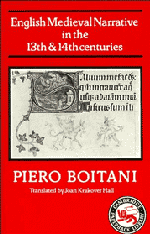5 - The Narrative Collections and Gower
Published online by Cambridge University Press: 04 April 2011
Summary
Along with the narrative elements so far examined – the exemplum, biblical paraphrase, hagiography, romances and visions – the fourteenth century saw the beginning of a completely new phase in the development of English narrative. This was the collection of stories set in a narrative frame. As we have already seen, the century opened, in 1303, with Robert Mannyng's composition of Handlyng Synne. But this work, adapted from the French, represents an intermediate stage, in which the organising principle is still purely abstract and doctrinal. Handlyng Synne is a collection of exempla meant to illustrate sins, sacraments and the advantages and the grace of confession; as its title indicates, it is a manual, the ultimate aim of which is the conversion of the sinner, his repentance and confession. I have also noted that Mannyng's work had a precise ‘political’ purpose: to provide a collection of stories that could successfully compete with the popularity of those entertainments that were judged ‘illicit’ by the Church authorities. Therefore Handlyng Synne contains a mixture of minutely realistic scenes of daily life and exempla designed to arouse the reader's curiosity and at the same time persuade him to reform his own life without further delay.
What changes is the course of the fourteenth century, and not only in England, is the character of the frame within which the stories are assembled: the frame itself becomes a narrative device, and at the same time an embryonic dramatic element.
- Type
- Chapter
- Information
- Publisher: Cambridge University PressPrint publication year: 1982



